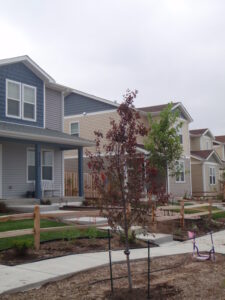This weekend, Pikes Peak Habitat is holding a groundbreaking in our community at The Ridge at Sand Creek. One of the future homeowners we’re celebrating is Gilas, who, along with her 12-year-old son, will move into a recycled home in a different Pikes Peak Habitat neighborhood, Woodmen Vistas.

If you aren’t familiar with a recycled home, read on!
Pikes Peak Habitat occasionally re-acquires homes that we already built and that have been previously occupied. This can happen in several ways. For example, one of our homeowners might leave us their house as a bequest in their will. If a Pikes Peak Habitat homeowner decides to sell their house, we may purchase it back to keep in our stock of affordable homes for El Paso County workforce families. These are called recycled homes.
We can also rehab homes, a process that occurs when we renovate a home constructed by another builder. We accept home donations for rehab on a case-by-case basis; for more information, please contact Emma Price, Assistant Donor Relations Manager, at emma@pikespeakhabitat.org.
When a house is added to our supply, we renovate the home before we sell it to a new family

“We’ll do our best to turn it into a brand new house, or at least comparable to a brand new house,” explains Eric Wells, Pikes Peak Habitat construction superintendent.
In the case of Gilas’ future home, the previous occupant, a Pikes Peak Habitat homeowner, spent more than a decade there. “It’s just been lived in,” says Wells. “We’re basically tearing things down to the drywall inside. All of the trim, all of the doors, all the flooring, all the cabinets are coming out.”
He adds, “The stuff that we do pull out that is in good condition, we’ll be sending to the ReStore [to sell], and those funds will go back into this house.”
 In addition to replacing the trim, interior and exterior doors, and the garage door, volunteers will prime and paint the walls and install new flooring. The home will also receive a new roof, thanks to a donation from Triton Roofing.
In addition to replacing the trim, interior and exterior doors, and the garage door, volunteers will prime and paint the walls and install new flooring. The home will also receive a new roof, thanks to a donation from Triton Roofing.
The house also will be upgraded with the same energy-efficient features we install in the newest homes we’ve built.
“We’ll be putting the hybrid water heater in there,” explains Wells. “We’ll be disconnecting the gas meter [and adding] mini-split system, radon system, Energy Star-rated fridge, new range, and microwave.”
He adds, “We won’t necessarily be able to take advantage of the new build rebates. We may not be able to get it Energy Star certified. But we will still be working towards reducing their utility bills as much as we can.”

Another way we’ve discovered to help lower utility bills is through our partnership with Colorado Springs Utilities to provide drought-resistant landscaping options. Part of the home recycle includes adding trees, shrubs, flowers, and grass that require minimal water and are well-suited to this climate. “We’ll be putting in new landscaping, the water-wise conservation landscaping,” Wells explains.
He expects the renovations to begin in December, with a view to finishing by March 2024. We’re currently seeking volunteer groups interested in working on the project. Alex St. Clair, Pikes Peak Habitat construction supervisor, will be on-site to work with crews.

For her part, Gilas is excited to invest sweat equity in transforming her new home.
“It’s going to be a great memory that you worked for this house!” she says. “And then you know, when maybe your friends come over, then you will say, ‘Well, when they were remodeling, I did this, I did this,’ you know, ‘This looks like this and right now it looks like that’—you have something to tell.”

